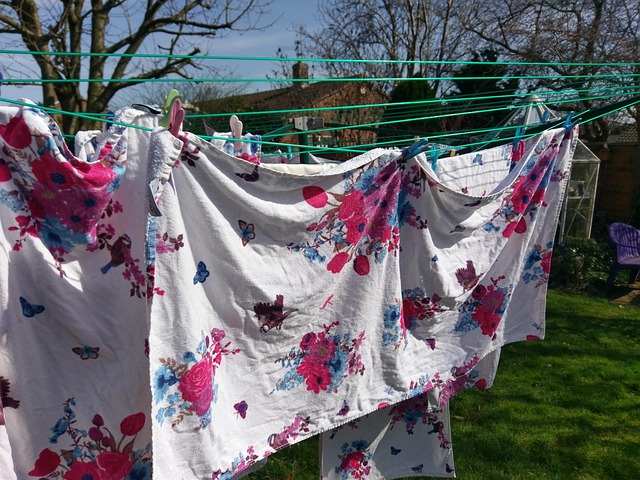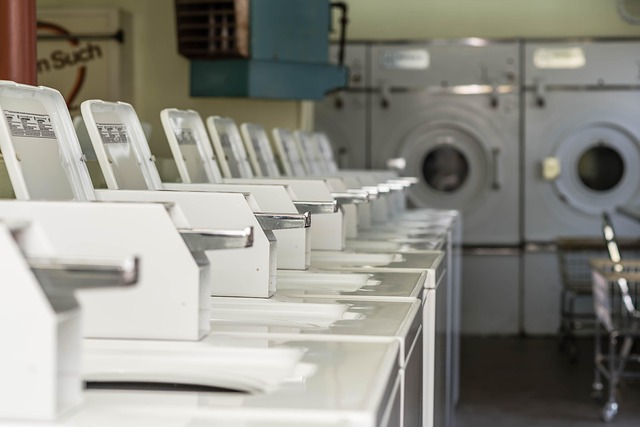I've been helping with laundry chores ever since I was small. In our first house that I remember from childhood, our "laundry room" was a dark corner of the basement where my mother had a washing machine, a dryer, probably a large utility sink (I don't remember for sure), and some ramshackle counter space and shelves. In hindsight, I suspect it was there because it was immediately beneath the kitchen with easy access to plumbing and an exterior wall for the dryer vent. The water heater and water softener were down in that area, too. My memory is a bit hazy because my help then was minimal. Mainly, I was probably helping match socks and fold things I could manage, like hand towels and washcloths. I also remember summers with clothes hung on the line in the back yard.

It wasn't until the next house when I was actively doing more of the work through the whole process. This was in a hallway upstairs in what has obviously been an addition. The water heater and water softener were in the basement again there, but someone ran pipes to the new part of the house for the sink and washer. This utility space was essentially a deep closet, and it could be hidden away behind a door so it wouldn't be on full display. We still used a clothesline outside. I will note, however, that this was a very seasonal option. Every year, there were about 13 months of winter where a dryer was essential.
After my family moved to the Pacific Northwest, the new house had a basement laundry room again, but this was a bit more of a finished space than some stuff tucked in the corner. However, the room was long, narrow, and awkward. There were some shelves, and we installed more over the years, but it was always a bit more of a "make do with what you have" than an ideal workspace. Again, we had a clothesline, although this was strung between trees instead of using T-shaped metal posts with parallel lines.
When I got my first apartment, it had no laundry space. I relied on a public laundromat a few blocks away. I have also used laundromat occasionally when traveling. I have avoided owning anything requiring dry-cleaning, and I haven't personally used a laundry service.

My second apartment, however, had hookups for laundry in a room next to the kitchen, and it adjoined a "half-bath" with a toilet and sink, all underneath the upstairs bathroom. It was largely dictated by plumbing, but the use of space was clearly intentional as well. I had to supply my own appliances. I bought them used, and sold them again when I moved out. No line-drying there. I used a clothes dryer exclusively. No one needed to see my tighty-whities!
I think these experiences cover most common laundry spaces: none, a dedicated space, or an afterthought. However, there is also a popular option I drew in blueprints during my short career as a draftsman: the mud room. Many suburban homes are designed so the garage accesses the kitchen through a utility room where boots, jackets, etc. can be stored. This space is also often designed with room for laundry, which makes sense because it is near the kitchen for plumbing access, and families often have kids who need to shed dirty clothes before tracking mud through the house, so why not have the laundry right there, too?
But that leads into another point: The USA and Canada, especially here in the west, are quite newly settled. Most homes are designed with modern plumbing and electricity from the start. Modern appliances are an assumption baked into the blueprints. Historically, laundry was another matter entirely. I remember the Little House books by Laura Ingalls Wilder listing the chores by day:
Wash on Monday
Iron on Tuesday
Mend on Wednesday
Churn on Thursday
Clean on Friday
Bake on Saturday
Rest on Sunday
Yes, I had to look up the list. I remember it existed, but not the details. It was a major chore, too. Bernadette Banner demonstrated the process according to Edwardian home economics manuals in the
 https://youtu.be/88Wv0xZBSTI
https://youtu.be/88Wv0xZBSTIObviously, homes built in that era were not designed for modern laundry. Most weren't even designed for electricity, gas, or indoor plumbing! These homes may have a washing machine in the kitchen now because that was where utilities were all installed, and if I am not mistaken, that tradition extends to new construction. It makes a degree of sense, too. After all, water for washing the old-fashioned way would have been boiled on the stovetop there already. There are countertops for folding and sorting in place. One can switch from cooking to laundry as timing allows thanks to modern conveniences.
Is your washer in the kitchen, or do you have a dedicated laundry room? What is the norm in your country? Do you have an odd setup or some clever ideas to suggest for anyone remodeling/building a laundry room? Let me know in the comments, and share a snapshot if you dare! I won't judge. I won't share pics of my own, though. No one needs to see that.
 **[HIVE](https://hive.blog/@jacobtothe/posts) | [PeakD](https://peakd.com/@jacobtothe/posts) | [Ecency](https://ecency.com/@jacobtothe/posts) | [LEO](https://inleo.io/profile/jacobtothe)**
*If you're not on Hive yet, I invite you to join through [InLeo](https://inleo.io) or [PeakD.](https://peakd.com) If you use either of my [referral](https://inleo.io/signup?referral=jacobtothe) [links,](https://peakd.com/register?ref=jacobtothe) I'll even try to delegate some Hive Power to help you get started.*
**[HIVE](https://hive.blog/@jacobtothe/posts) | [PeakD](https://peakd.com/@jacobtothe/posts) | [Ecency](https://ecency.com/@jacobtothe/posts) | [LEO](https://inleo.io/profile/jacobtothe)**
*If you're not on Hive yet, I invite you to join through [InLeo](https://inleo.io) or [PeakD.](https://peakd.com) If you use either of my [referral](https://inleo.io/signup?referral=jacobtothe) [links,](https://peakd.com/register?ref=jacobtothe) I'll even try to delegate some Hive Power to help you get started.*

 https://youtu.be/88Wv0xZBSTI
https://youtu.be/88Wv0xZBSTI